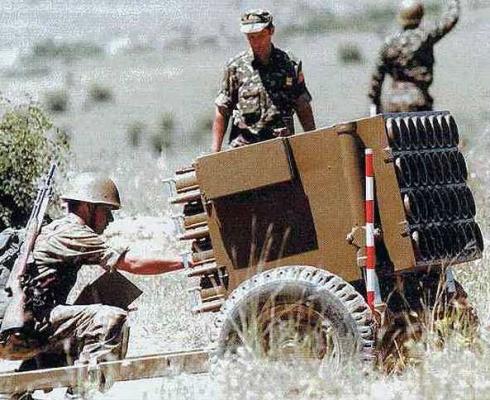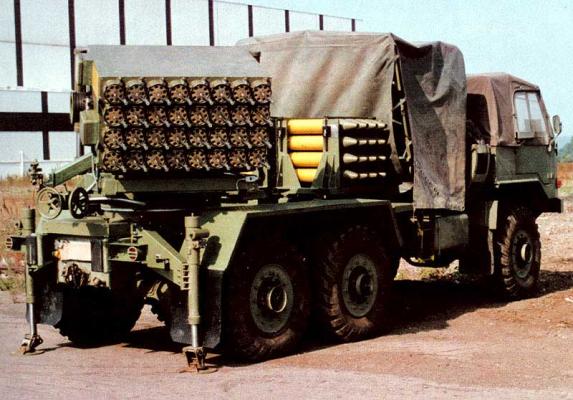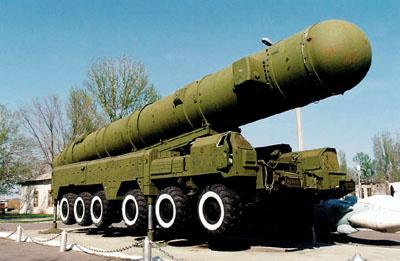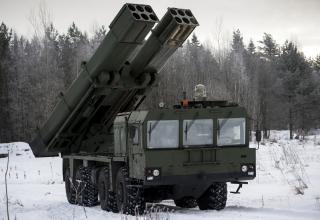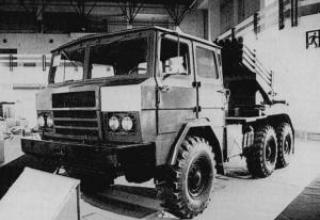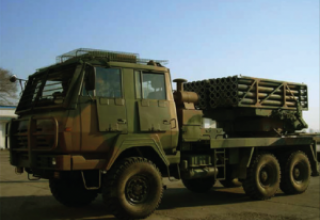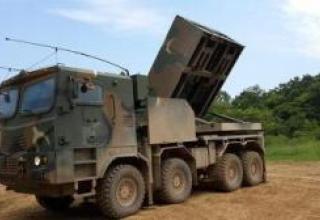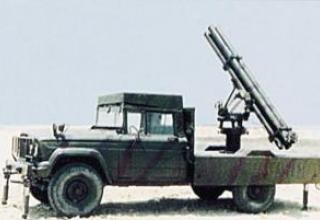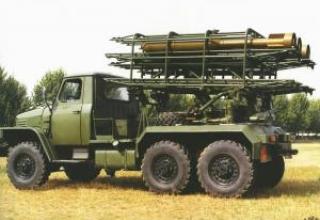The 128-mm "Plamen" multiple rocket launcher system is a direct fire support system for the troops of the front edge. The system is designed to inflict operational and powerful strikes on manpower, lightly armored enemy vehicles in places of concentration and on the march, the destruction of command posts, communication centers, airports and military industrial infrastructure.
Development of the first version of the system began in 1958 and ended in 1963 with the adoption of the Yugoslav People's Army towed 32-barreled M63 rocket launcher. During the long years of service the system was repeatedly upgraded, ammunition was improved in order to increase its power and range of fire. The last member of the 128-mm "Plamen" multiple launch system family is the M94 "Plamen-S" mobile combat vehicle with increased range up to 12.6 km.
At present, the Plamen" family of MLRSs includes the following systems, unified in terms of the ammunition used:
- a towed M63 "Plamen-A" launcher;
- M71 "Partizan" portable single barrel launcher, designed for armament of special forces;
- M94 "Plamen-S" mobile combat vehicle on cross-country vehicle chassis;
- 8-round M63 "Plamen-R" launcher on UAZ-469 light truck chassis (pilot version);
Plamen" RSF is in service with the ground forces of Serbia (18 M94, 60 M63), Macedonia (12 M63), Slovenia (4 M63), Cyprus (18 M63), Georgia (12 M94) and Croatia. The Croatian Army has developed its own versions of 128 mm calibre launchers - RAK-12 and RAK-24 with 12 and 24 guides respectively. Organizational units armed with M63 "Plamen" RSFs were united into jet divisions consisting of three batteries with four launchers each.
MLRS "Plamen" was widely used during the civil war in Yugoslavia by almost all conflicting parties.
The 4th infantry brigade of the Georgian army, which stormed the city of Tskhinvali (South Ossetia) on the night of August 8, 2008, had a missile division of MLRS "Plamen" (12 pcs.). The information about the results of the application of the Plamen MLRS in the course of this operation is absent.
Composition:
Starting installation M63 is a package of 32 guides placed on a carriage with sliding beds (ground clearance - 268 mm, track width - 1892 mm). Guidance mechanisms, fire control and sighting unit are mounted on the left side of the guide package. The standard towing vehicle is the TAM 1500 truck (4x4 wheel arrangement), which is also used to transport ammunition. The calculation consists of seven numbers.
The combat vehicle (BM) M94 "Plamen-S" is placed on the modified chassis of the truck TAM-150 T11 BV with the wheel configuration 6x6 (or any other with similar characteristics, such as FAP 1417). Artillery part (similar to M63) includes a package of 32 tubular rails, swivel base with guidance mechanisms and sighting devices, as well as electrical equipment. Guidance mechanism drive is manual. To increase the combat vehicle stability when firing at the rear of the chassis, two supports with jacks are mounted.
When the vehicle weighs 9.6t, the M94 "Plamen-S" develops a maximum speed of 80km/h on the highway. The combat vehicle is equipped with a V-shaped diesel air cooling (produced under license from the company "Klockner-Humboldt-Deutz" Germany). The fuel consumption is 30l per 100km. BM M94 is equipped with a centralized pressure control system in tires (from 0.7 to 3.5 bar), which is operated from the driver's cab. In the hiking position, the artillery unit is closed with a removable tent. The fire is controlled by a remote control via cable.
Between the cockpit and the launcher there is an additional rack with 32 rockets for fast recharging. For recharging, the artillery unit guide package is rotated 180° and mounted at zero elevation angle. The projectiles on the rack are simultaneously pushed into the rails by a hydraulic device. Recharging of the PM can also be carried out manually.
The time of transfer of the M94 from camping to combat position is within one minute.
Unguided turbojet shells (TRS) of 128mm M63 and M87 caliber are used for firing. The TRS is equipped with a solid propellant engine with eight helical nozzles ensuring rotation of the projectile in flight (see diagram). The head part is shrapnel-flagged with the weight of 7.55 kg and is equipped with a TNT charge. The M87 TPC has an improved engine which provides an increased range up to 12.625 km.
Shooting is carried out by single MPC, several MPC or salvo at 0.2s, 0.4s or 0.6s intervals.
Characteristics:
| M63 launcher | |
| The dimensions of the BM, mm: - hiking length - firing length - hiking width - hiking altitude |
3682 3650 2212 1278 |
| Unit weight, kg: - uncharged - charged |
1395 2134 |
| Calculation, man. | 7 |
| Recharging time, min | 5 |
| Number of guides, pcs. | 32 |
| Guide length, mm | 1030 |
| Angle of elevation, deg: - minimum - maximum |
0 +48 |
| Horizontal pointing angle, deg | ±15 |
| TRS M63 | |
| Caliber, mm | 128 |
| Length with fuse, mm | 814 (according to other data 837) |
| Length of the head end, mm | 200 |
| Weight, kg | 23.1 |
| Weight of the head end, kg | 7.55 |
| Weight VHF HF, kg | 2.3 (according to other data 2.6) |
| Powder charge weight RDTT, kg | 4.78 |
| Maximum flight speed, m/s | 420 |
| Range of flight, m: - minimum - maximum |
2000 8600 |
| Operating temperature range | between -30 and +45°C |
| TRS M87 | |
| Caliber, mm | 128 |
| Length, mm | 971 |
| Weight, kg | 25.5 |
| Weight of the head end, kg | 7.5 |
| Weight VHF HF, kg | 3.3 |
| Range of flight, m: - minimum - maximum |
2000 12625 |
| Operating temperature range | between -30 and +45°C |
Testing:
Flight tests of RSD-10 missiles began in September 1974 at the Kapustin Yar proving ground. In 1977, immediately after the complex was adopted for service by the USSR Strategic Missile Forces, its deployment began. The first missile regiment with the Pioneer complex went on combat duty on August 30, 1976 (Petrikov district, Gomel region commander A.G. Doronin). Mass deployment of the "Pioneer" complex began in 1978 in the position areas previously occupied by obsolete complexes with missiles R-16. Each missile regiment consisted of 6-9 self-propelled PU, provided with individual protective structures.
According to American data, the largest number of deployed launchers was 441 in 1986. According to the Soviet official data given in the Memorandum of Agreement on the Establishment of Initial Data in connection with the treaty between the USSR and the United States on the elimination of medium- and shorter-range missiles, as of November 1, 1987 in the USSR was deployed 405 RSD-10 missiles, another 245 ballistic missiles were in storage.
During the 15 years of operation, there have been no missile failures or accidents. During testing, operation and liquidation 190 missiles were fired. All the launches were successful. At the same time, the probability of hitting the target left 98%.
Sources:
- M63/94 self-propelled multi-tube missile launcher 128 mm - PLAMEN C
- Гуров С.В. "Реактивные системы залпового огня" . -Тула.: "Пересвет", 2006 - С.381,399,403.
